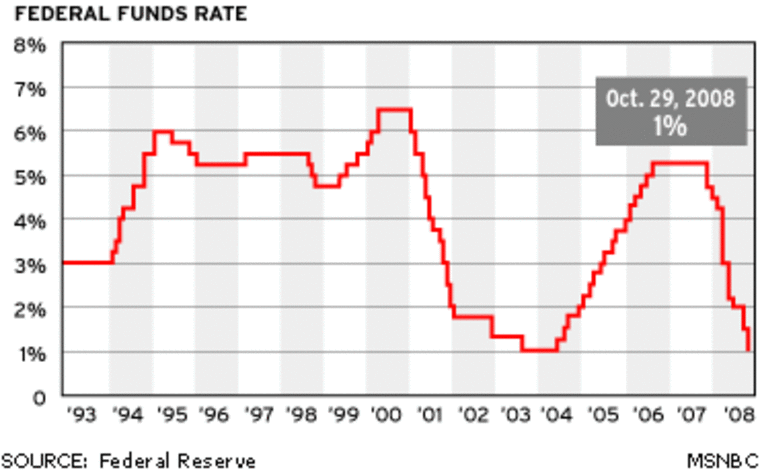The Federal Reserve raised short-term interest rates another quarter-point Tuesday and signaled more increases to come, boosting borrowing costs for businesses and consumers.
With Alan Greenspan down to his final three months as chairman, Fed policy-makers pushed up the overnight bank lending rate for the 12th time in 16 months to 4 percent, its highest level since June 2001. Commercial banks were expected to follow quickly by raising their prime lending rate a quarter-point to 7 percent, affecting home equity credit lines, business loans and credit card interest rates.
In a statement announcing the rate hike, the Fed reiterated that policy-makers still consider rates relatively low, or accommodative, and intend to continue raising them "at a pace that is likely to be measured." Most analysts believe that means another quarter-point hike when the Fed rate-setting panel meets Dec. 13 and probably one more Jan. 31, at what is scheduled to be the final meeting of Greenspan's 18-year tenure.
White House economic adviser Ben Bernanke, nominated last week by President Bush to succeed Greenspan, is expected to take over the powerful post, assuming he wins Senate approval as expected.
Alan Blinder, a Princeton University economist and former Fed governor, said Greenspan would have inserted new language in the statement if he intended to raise rates only one more time. Instead the Fed left in boilerplate wording it has used since mid-2004 to signal steady quarter-point increases.
"There is no change in course, and markets have already priced in more action," said Steven Wieting, senior economist at Citigroup.
The Fed acknowledged that "hurricane-related disruptions had slowed the economy in recent months but said rebuilding in the hardest-hit areas would reverse that impact and boost production.
"The cumulative rise in energy and other costs have the potential to add to inflation pressures; however, core inflation has been relatively low in recent months and longer-term inflation expectations remain contained," the Fed said.
Financial stocks fell slightly but the broader market was barely affected by the rate hike, which was widely expected. The Dow Jones industrial average closed with a loss of 32 points, ending just where it was when the Fed announced its decision shortly after 2 p.m. ET.
Wieting said most of the inflation pressure seen so far has been caused by supply-related issues including damage from hurricanes Katrina and Rita, which has driven up the costs of fuel and building supplies. By continuing to raise rates, the Fed is aiming to cool consumer demand so that inflation expectations to not broaden and become self-fulfilling.
"This whole inflation threat has, on balance, moved up over the past couple of months," he said.
As consumers have been forced to spend more for fuel, other spending has started to suffer, and car sales have slowed substantially since manufacturers ended popular deep discounts over the summer. But Fed officials appear comfortable that output will be boosted in coming months as manufacturers rebuild inventory and reconstruction money begins to pour into the battered Gulf Coast.
The vote to raise the so-called federal funds rate to 4 percent was unanimous, with Greenspan supported by the other nine voting members of the Federal Open Market Committee. And the panel approved a related request by all 12 regional Fed banks to raise the less commonly used discount rate.
"I think you've got to say their statement is about as hawkish as you could reasonably have expected under the circumstances," said Jan Hatzius, senior economist at Goldman Sachs.
Bernanke has pledged to follow the policies and strategies laid down by Greenspan over his 18 years in the powerful post, although he could feel some pressure to establish his credentials early on as an inflation fighter, following in the path of Greenspan and his predecessor, Paul Volcker. The Senate is expected to confirm Bernanke by the end of the year, in time for him to take over Feb. 1.
The rising interest rates are beginning to bite. Although mortgage rates drifted lower for the first year after the Fed began its rate-hike campaign, they have been moving steadily higher over the past two months.
As mortgage rates rise, many analysts expect home sales and construction to slow next year from the record pace of the past three years. That would be a blow to the economy, as housing has been one of the most dependable engines of growth since the collapse of the technology-stock bubble in 2000.
Hatzius said he is concerned about a "Wile E. Coyote" economy next year that starts off strong and then falls off a cliff after the boost from hurricane rebuilding wears off.
Bill Gross, managing director of Pimco, the giant bond management company, agreed that growth is likely to slow substantially next year and said the economy could even dip into recession if the housing market crashes.
“I think that is the key here,” he said on CNBC. “If housing cracks in the United States then there is a possibility of recession. But it is a slim possibility.”
